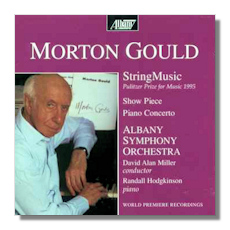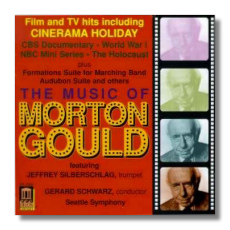
The Internet's Premier Classical Music Source
Related Links
- M. Gould Reviews
- Latest Reviews
- More Reviews
-
By Composer
-
Collections
DVD & Blu-ray
Books
Concert Reviews
Articles/Interviews
Software
Audio
Search Amazon
Recommended Links
Site News
 CD Review
CD Review
Morton Gould

Film and Concert Music
- Show Piece for Orchestra (1954)
- Piano Concerto (1938)
- StringMusic (1994)
Randall Hodgkinson, piano
Albany Symphony Orchestra/David Alan Miller
Albany TROY300 70:12


- Pavane (from Symphonette #2) 1
- Music from Cinerama Holiday, World War I, and Holocaust 1
- "Interlude" (from Festive Music) 1
- Formations: Suite for Marching Band
- Concerto Grosso for 4 solo violins and orchestra 2
1 Jeffrey Silberschlag, trumpet
2 John Weller, Mikhail Shmidt, Maria Larionoff, Mariel Bailey (violins)
Seattle Symphony Orchestra/Gerard Schwarz
Delos DE3166 60:47
Summary for the Busy Executive: Solid Gould.
Of first-rank American composers, Morton Gould stands among the least known and most distinctive. A composing prodigy, he began writing full score almost immediately and worked as a CBS staff arranger while still in his teens, back in the days when CBS and NBC both ran network orchestras. He wrote music both as required and as he pleased. I consider him that rarest of birds, the fine composer with the ethic and technique of the complete pro.
Gould's music sounds personal without strain. Like many of his generation, he sought to integrate pop and classical – to arrive at a distinctly American-sounding music that would speak to large masses of people. He incorporated jazz (or what was loosely called "jazz" 'way back when), folk music, spirituals, and the dances from the late nineteenth and early twentieth centuries. He wrote concert pieces, musicals intended for Broadway (Billion Dollar Baby with Comden and Greene, Enter Juliet with Carolyn Leigh), radio music, TWV and film scores, and "concept" LP albums. He championed Ives early on, and the older composer influenced him. The music shows wit, power, great energy, as well as a focus and clarity Ives often lacks. It's even pretty, a rather rare quality. He also conducted and made, as they say, a good living.
With all of this going for him, we can ask why he isn't better known or why he's usually left out of serious discussions of American music. Anything I'd have to say would be a guess, so take the following with a grain of salt. Although he received prestigious commissions throughout his career, Gould never belonged to a circle of composers. He was out of the Copland sphere of influence, for example. As far as I know, Copland never beat the drum for Gould. Furthermore, Gould was kept out of a major New York venue for many years because of a long-running feud with Leonard Bernstein, undoubtedly the greatest proselytizer for American music of his time.
Gould's music divides roughly into "serious" and "light." He has more pops pieces in his catalogue than most composers mainly because he worked successfully as a commercial musician. That so many of these bon-bons should be so distinguished musically comes down to a matter of talent and craft. The Delos CD concentrates on the lighter Gould, the Albany on the concert composer.
The "Pavanne" (Gould spelled it this way to "facilitate pronunciation") qualifies as one of Gould's genuine hits – sort of an American take on Prokofieff's "March" from The Love of Three Oranges. Benny Goodman even played an arrangement of it, but it's a bit of a shame, since this is the only part of the Symphonette that gets played and the other movements, particularly the finale, are terrific. You can hear all three movements on Albany TROY013-014, if still available.
I remember seeing Cinerama Holiday in a theater especially equipped with three screens and three projectors – one for left, one for right, and one for center image. I even heard talk of permanently converting the theater, since Cinerama was going to be the Next Big Thing. It didn't work out that way. I was still a kid, but I remember asking myself why this was supposed to be so wonderful. Apparently, others had the same idea. It was a notion – "Wider Screen Is Better" – as much of its time as tail fins on automobiles. At any rate, I didn't remember the music. Gould's contributions show him as a good movie composer, with the ability to evoke place or mood instantly. Much of this has to do with his ability to mimic other styles. For Cinerama Holiday, it's the music of Les Six. For the documentary World War I, it's the ballroom dances of the Edwardian period. However, even here Gould manages to do something interesting. In the "Prologue and Drum Waltz" to World War I, Gould sets march rhythms (4/4) against a symphonic waltz (3/4), and it all fits together like a jigsaw puzzle. Part of this suite also includes a movement called "Sad Song," which essentially cheats – imitating the cabaret styles of Weill and Eisler. As the liner notes remark, you can almost hear Lotte Lenya and see the smoke curling from her cigarette. The complete suite for the television mini-series Holocaust appears in a fine recording by David Amos and the Kraków Philharmonic on Koch 3-7020-2.
Incidentally, all of the above pieces are heard in Gould's own arrangement for the trumpeter Jeffrey Silberschlag, who performs them here. The only disappointment is the "Pavanne," which sounds wittier in its original scoring.
Festive Music's "Interlude" pays tribute to Bix Beiderbecke. It sounds like one of Beiderbecke's impressionistic piano pieces, like "In a Mist." As far as I know, no one has recorded the entire suite. This section is lovely, emotionally close to Copland's Quiet City.
Formations, originally written for the University of Florida Marching Band and dedicated to the composer's sons (in college at the time), also found life in the theater when Elliot Feld used it for his ballet Half-Time. Gould has written several major works for band (including at least one symphony), and the woodwind choirs have always elicited something special from him. He pulls off the following trick: marching-band music ten times better than most marching-band music.
For me, the most ambitious work on the Delos CD is the Concerto Grosso for four solo violins and orchestra, part of Gould's score for the Balanchine ballet Audubon. It has four movements: "Prélude and Fugue," "Air," "Variations," and "Rondo." Here we see Gould's craft at its most stupendous, but Gould doesn't make craft an end in itself. This is primarily dance music. The independent strands of Gould's counterpoint contribute to the rhythmic excitement of the fast movements and point out the exquisite simultaneous separateness of solo dancers in the slow movements. It must have made Balanchine's heart skip a couple of beats, for this music fits dance theater like Spandex. The liner notes try to make a case for the "Variations" section as influenced by minimalism, but my ears tell me different. I hear little affinity, in fact, with, say, Glass, Young, or any other standard-brand minimalist. Despite the implications of the movement titles, Gould doesn't work the standard neoclassical riffs. The work doesn't come across as Olde Worlde with a twist, but as thoroughly current.
Columbia Records commissioned Gould's Show Piece as a hi-fi demo that showed off their recording technology. Ormandy and the Philadelphia premièred the work and even recorded it, although Ormandy, dissatisfied with the sessions, refused to allow the recording's release. As befits the commission and the intended orchestra, Gould shows off all the sections, much as Britten did in his hi-fi demo classic Young Person's Guide to the Orchestra. Gould is less systematic than Britten, but I find it interesting that both composers use theme and variations as their formal skeleton, with Gould adding the wrinkle that the first variation precedes the theme.
The work divides into the following movements: "Tune Up," "Theme," "Scene," "March," "Serenade," "Ballad," and "Toccata." "Tune Up" conjures up that familiar pre-concert orchestral sound. From an a on the oboe, various fragments of the theme coalesce to form a gorgeous D-major chord which spreads over the orchestra and crumbles to glitter. The theme lacks a really strong profile, however, and it takes a bit of work to figure out the exact relations of the variations to the theme. Fortunately, however, each piece stands on its own. The surprises in the orchestration will make your jaw drOp. It's not merely new, it's also convincing. What comes across is Gould's wit, but that may be too faint a word for what Gould provides, especially when we tend to devalue wit in favor of "deep." Mozart's Symphony #40 (in a minor key) probably ranks higher in people's estimation than his Symphony #39. Yet it's much harder to make up a joke than a sermon.
Gould, a pianist himself, has written several concerted works for the instrument. The concerto is one of the finest by an American. Written in 1938, until the Nineties it enjoyed only its première performance, a radio broadcast with Gould as soloist and Wallenstein conducting. Amazing. Gould liked to point out its similarities to Stravinsky ("That Stravinsky's been stealing from me since I was a kid"). To me, it resembles more the Prokofieff second concerto. There's almost no revamping of Baroque or Classical keyboard fingerings, and the rhythm taps out more lyrically than I find in Stravinsky. It's gracious, vivacious music – traditional fast-slow-fast – a real find.
StringMusic finally won for its composer a Pulitzer Prize, shortly before his death. It's a wonderful piece, but no more wonderful than many works in Gould's catalogue: Fall River Legend, Interplay, Derivations, the Concerto Grosso, Soundings, Columbia, Spirituals for Orchestra, Venice Audiograph, or Vivaldi Gallery, to name some favorites off the top of my head. The sound of the ensemble always figures prominently in Gould's work. Here, he manages to get a variety of colors from the largely "black-and-white" string orchestra, not only through textural invention and antiphonal voicing but also through different bowings, fingerings, and plucks. Many of these techniques have become cliches of the avant-garde, but Gould manages to integrate them into the total affect of the piece. Structurally, the work is a wonder, with Gould working through complex rhetorical progressions without apparently breaking a sweat. Gould's command of symphonic planning and string color reminds me of Tchaikovsky's masterpiece Serenade in C. Above all, Gould soars to a high level of thematic and harmonic invention. He not only says complicated things clearly, he has something persuasive to say.
The performances, all professional, nevertheless do not stand out. I find Schwarz and the Seattle on this occasion a bit gauche, antithetical to the elegance and wit of the music. Miller and the Albany have a restricted dynamic range (they can't play a true piano or less) and are a bit lax as far as intonation and rhythm go. Consequently, they lose some of Gould's most striking effects. Still, the performances are by no means terrible and are furthermore the only recordings of these marvelous works we're likely to see for a while. The sound on both discs is good.
Copyright © 2000, Steve Schwartz




















